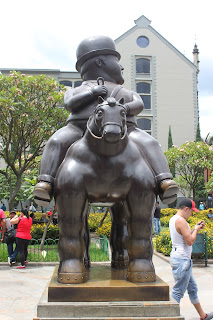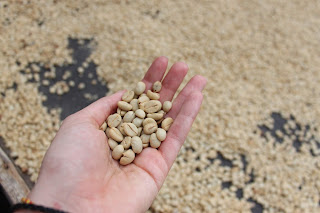Its always fun having friends from other countries come to visit the country you’re in. I love showing people around, where I live, where I work, introducing them to the local foods, and of course meeting the people who have welcomed me into the country.
The week Hanfei came was a blast. I was able to show her around Bogota and some of my favorite places as well as explore a new region of Colombia together. Hanfei is very spontaneous which made exploring new places fun.
On her first day in Colombia we went to the Eje Cafetero or the coffee region of Colombia. This is where a lot of very good coffee is grown. Since Hanfei and I both love coffee we were excited to be in the region where it was grown. We stayed two nights in Armenia, the capital of that “state.” The remaining of our days in Eje Cafetero we spent in Salento, a cute touristy town located near Cocora Valley.
 |
| Many of the buildings and houses in Salento were brightly painted |
 |
| Salento's center |
We stayed in a hostel where we met a lot of interesting tourists. We were amazed at the extent of travels our fellow guests had pursued. Several of these travellers spent weeks traveling around the world. Since we only had one week of vacation we had to make the most of it.
 |
We made two friends at the hostel: Rahul and Alex.
We are in the back of the Jeep going from our hostel to Salento. |
One of our nights in Salento we played Tejo with two friends we met at the hostel. Tejo is a game where you toss a rock and try to hit triangular, gunpowder pieces. Every time you hit the piece, it ignites a small explosion. There were about eight to ten such triangles placed in a circle on soft clay. Players stand about twenty meters back and toss their “rock” hoping that it lands on the gunpowder. Although we were not very good, it was fun.
Our time in the Eje Cafatero was relaxing and full of spontaneous adventures. We walked around Salento taking photos of the brightly painted houses and shops. Since we were in the coffee region of Colombia, we had to order coffee at every place we went. Some of the regional food we tried was trout with a tomato onion salsa and plantains with tomato, onion and beef sauce. All was delicious.
We also explored the surrounding areas of Salento. We hiked part of Cocora Valley, and went on a coffee tour. Seeing the mountains and the tall palm trees made me think of Haiti. It was seriously beautiful. On the coffee tour we learned all about Colombian coffee. I guess you can call us coffee experts now. (To read how coffee was made on the coffee farm we went to, click here).
 |
| Cocora Valley |
 |
| Looking up at the worlds tallest palm trees. |
 |
| Bright purple flowers |
 |
| Rahul |
 |
| More photos of Cocora Valley |
Back in Bogota, on Good Friday we climbed Monserrate. Monserrate is one of the places Colombians traditionally go to on Holy Week as a pilgrimage. Thus, we were among thousands that day. It was my first time walking the trail, as on a previous visit, I rode a train. I was excited to try something new. Hanfei and I climbed it in less than an hour and were quite proud of ourselves for that. We did not stay long, however as the amount of people was overwhelming. It was Good Friday and it seemed half of Bogota was climbing the Monserrate that day. We estimated that it could have taken us a less than an hour to hike down, but because of the crowds, they led us through a different mountain trail, which took us over three hours. It felt like we were in the Exodus. It was definitely an experience going on Good Friday, but not one I would recommend.
 |
| The last night out dancing with the "Daniels" |
Saturday was Hanfei’s last day, so we crammed in as much as possible. We purchased gifts for all her friends and co-workers. We ended the day going out dancing. My friends, the Daniels, joined us and it made for a good end to the trip.
I am extremely blessed to have a friend like Hanfei and that she was able to take time out of her busy life to visit me.



























































